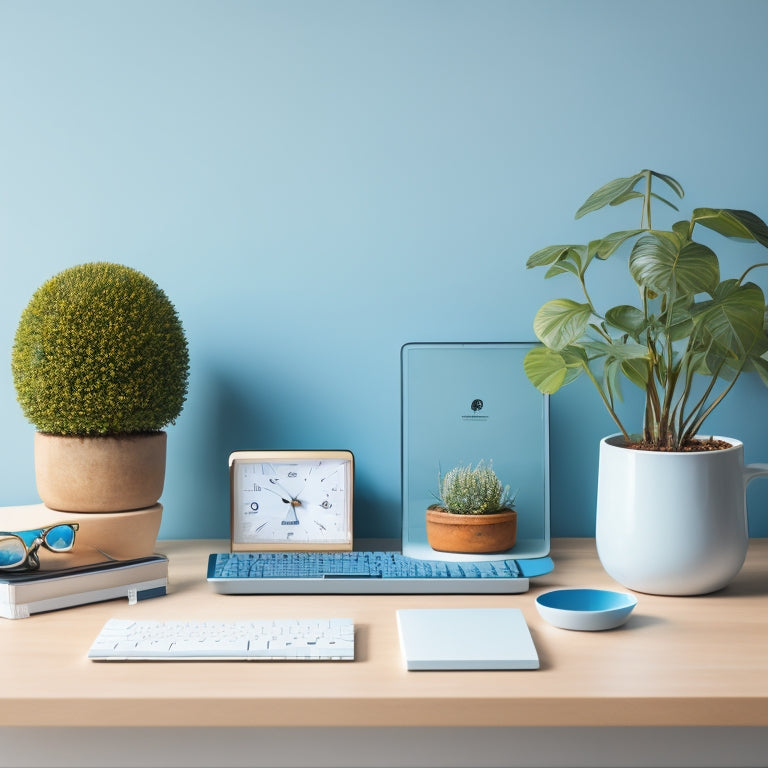
Tame Digital Chaos With These Proven Strategies
Share
You're tired of feeling digitally overwhelmed, and it's time to take control. Start by simplifying your digital toolbox - identify the necessary apps and services, and get rid of the rest. Next, streamline your email inbox by unsubscribing from unwanted emails, using filters, and implementing the 2-minute rule. Master your digital calendar by syncing multiple calendars and prioritizing tasks. Organize your computer files by categorizing and designing a logical folder structure. Tame social media overwhelm by limiting your time spent on platforms and unfollowing accounts that don't add value. Finally, secure your online identity with unique passwords and two-factor authentication. You're just getting started - there's more to explore.
Key Takeaways
• Simplify your digital tools by categorizing them into must-haves, nice-to-haves, and never-useds, and consider consolidating into all-in-one solutions.
• Implement efficient email management by unsubscribing from unwanted emails, using filters and labels, and adopting the 2-minute rule and good email etiquette.
• Optimize your digital calendar by syncing multiple calendars, setting realistic reminders, and prioritizing tasks using Time Blocking to maximize productivity.
• Organize your computer files effectively by categorizing them by type, designing a logical folder structure, and creating a data backup plan to prevent losses.
• Enhance your online security by using a password manager, enabling two-factor authentication, and being cautious with unfamiliar emails, links, and attachments.
Simplify Your Digital Toolbox
Simplify Your Digital Toolbox
Start by taking stock of your digital toolbox, identifying which apps, services, and platforms you truly need to achieve your goals and which ones are simply cluttering your digital landscape. You're likely suffering from App Overload, where the sheer number of tools and platforms you're using is causing more stress than productivity. It's time for some Digital Decluttering.
Begin by categorizing your tools into must-haves, nice-to-haves, and never-useds. Be ruthless – if you haven't used an app in the past month, it's probably safe to delete it.
Consider consolidating similar tools into a single platform or service. For instance, instead of using separate apps for project management, time tracking, and team communication, consider switching to an all-in-one solution.
Once you've pared down your digital toolbox, take the time to organize what's left. Create folders, set up workflows, and establish clear habits for using each tool.
Streamline Your Email Inbox
Now that you've decluttered your digital toolbox, it's time to tackle the digital space where you likely spend a significant amount of time: your email inbox. A cluttered inbox can lead to wasted time, missed deadlines, and increased stress levels. To tame this digital chaos, it is crucial to adopt good email etiquette and aim for Inbox Zero.
Here are three actionable strategies to help you streamline your email inbox:
| Strategy | Description | Benefits |
|---|---|---|
| Unsubscribe from unwanted emails | Remove yourself from unnecessary email lists | Reduce clutter and minimize distractions |
| Use filters and labels | Organize your emails into categories and prioritize tasks | Save time and stay focused |
| Implement the 2-minute rule | Respond to or delegate emails that take less than 2 minutes | Increase productivity and reduce stress |
Master Your Digital Calendar
Now it's time to get your digital calendar in order.
You'll start by syncing multiple calendars to make sure you have a single, unified view of your schedule.
Next, you'll set realistic reminders and prioritize tasks wisely to maximize your productivity and minimize stress.
Sync Multiple Calendars
To guarantee, it's crucial to sync your multiple calendars. Start by identifying all the calendars you're using, including your work calendar, personal calendar, and any shared calendars with family or friends.
Next, choose a primary calendar that will serve as your hub. You can then use calendar syncing tools or apps to connect your other calendars to your primary one. This will make certain that all your events and appointments are consolidated in one place, eliminating the risk of double-booking or missed appointments.
Once you've synced your calendars, implement Time Blocking to schedule dedicated time for tasks and activities. By doing so, you'll be able to visualize your day, prioritize tasks, and make the most of your time.
With a synced and organized calendar, you'll be able to regain control over your schedule and reduce digital chaos.
Set Realistic Reminders
By setting realistic reminders, you'll guarantee that notifications are timely and relevant, rather than overwhelming or distracting, and help you stay on track with your schedule and tasks.
When reminders are unrealistic, they can lead to Reminder Anxiety, causing you to feel overwhelmed and stressed. On the other hand, setting reminders that are too frequent can result in Notification Fatigue, making you less likely to take action.
To set realistic reminders, start by identifying your goals and priorities. Determine what tasks need reminders and when you need to be reminded. Be specific about the task, the deadline, and the frequency of the reminder.
For example, instead of setting a reminder to 'check emails,' set a reminder to 'respond to urgent emails by 10 am.' Make sure to leave some buffer time between reminders to avoid feeling overwhelmed.
Prioritize Tasks Wisely
To maximize your digital calendar's potential, categorize tasks into must-haves, should-haves, and nice-to-haves, and schedule them accordingly to guarantee a realistic and achievable daily plan.
This task segmentation enables you to focus on high-priority tasks first, ensuring you're tackling the most critical ones.
Create a Priority Matrix to visualize your tasks, categorizing them based on their level of importance and urgency.
This matrix will help you identify tasks that are both high-priority and high-urgency, allowing you to tackle them first.
Organize Your Computer Files
Now it's time to tackle the digital clutter on your computer.
You'll start by categorizing your files by type, designing a logical folder structure, and creating a data backup plan to prevent losses.
File Type Categorization
Your computer files are likely a jumbled mess of documents, images, videos, and more, making it difficult to find what you need when you need it. It's time to tame the chaos by implementing a file type categorization system.
Start by identifying the main categories of files you work with, such as documents, images, videos, and audio files. Then, create subcategories within each group, like 'work documents,' 'personal documents,' 'photos,' and 'music.' This will help you establish a clear file pattern.
Next, develop a data taxonomy that makes sense for your specific needs. For instance, you might categorize documents by project, date, or type. Be consistent in your naming conventions and use clear, descriptive file names. This will enable you to quickly locate files and avoid duplicate or misplaced files.
Folder Structure Design
Design a logical folder structure by creating a hierarchy of folders and subfolders that mirror the categories and subcategories you established in your file type categorization system. This will help you maintain a sense of order and make it easier to find specific files when you need them.
Here are some tips to keep in mind when designing your folder structure:
-
Keep it simple: Avoid creating too many subfolders or using overly complex naming conventions.
-
Use clear and descriptive names: Choose names that accurately reflect the contents of each folder and subfolder.
-
Group similar files together: Store files of the same type or related to the same project in the same folder or subfolder.
- Plan for cloud migration: Consider how your folder structure will translate to cloud storage services, and design it with file architecture in mind.
Data Backup Plan
With your newly designed folder structure in place, now it's time to guarantee the safety of your organized computer files by implementing a data backup plan. This guarantees that your files are protected from loss or corruption due to hardware failure, software issues, or even natural disasters.
To create an effective data backup plan, consider the 3-2-1 rule:
| Backup Strategy | Description |
|---|---|
| 3 Copies | Keep three copies of your data: the original, a local backup, and a remote backup. |
| 2 Storage Types | Use two different storage types: an internal hard drive and an external hard drive or cloud storage. |
| 1 Offsite Copy | Store one copy of your data offsite, such as in cloud storage, to protect against disaster recovery scenarios. |
| Automated Backups | Set up automated backups to run at regular intervals, such as daily or weekly. |
| Regularly Test | Regularly test your backups to ensure they are complete and can be restored if needed. |
Tame Social Media Overwhelm
Social media platforms, once hailed as revolutionary tools for connection and community-building, have devolved into noisy, attention-sucking vortexes that can quickly overwhelm even the most seasoned digital natives. You're not alone if you feel like you're drowning in a sea of updates, notifications, and endless scrolling.
It's time to take back control and tame social media overwhelm.
Here are some strategies to help you do just that:
-
Set Social Boundaries: Establish specific times for social media use, and stick to those times. This will help you avoid mindless scrolling and reduce the likelihood of getting sucked into the vortex.
-
Curate Your Content: Unfollow or mute accounts that don't bring value or joy to your life. You don't need to see every single post from every single friend or follower.
-
Use Technology to Your Advantage: Utilize website blockers or app limitations to restrict your access to social media during certain times of the day or for a set period.
- Schedule Social Media Time: Treat social media like any other task and schedule it into your day. This will help you stay focused and avoid procrastination.
Secure Your Online Identity
You're only as secure as your weakest online password, and hackers are constantly on the lookout for vulnerable accounts to exploit. That's why it's essential to prioritize password management.
Start by using a password manager to generate and store unique, complex passwords for each of your online accounts. This will help prevent hackers from gaining access to your sensitive information.
Next, enable two-factor authentication (2FA) whenever possible. This adds an extra layer of security to your accounts, making it much harder for hackers to breach them.
Be cautious when clicking on links or downloading attachments from unfamiliar emails, as these can be phishing scams designed to steal your login credentials.
Frequently Asked Questions
How Do I Avoid Digital Distractions During Focused Work Sessions?
To avoid digital distractions, you'll want to try time blocking, scheduling focused work sessions without notifications, and set app limits on social media or email to minimize interruptions, allowing you to stay on track.
Can I Really Trust Password Manager Security?
You're right to wonder if password managers are secure; rest assured, they use robust password encryption and zero-knowledge protocols, ensuring your data remains private and protected, so you can trust them with your sensitive info.
What's the Best Way to Handle Online Harassment or Cyberbullying?
When faced with online harassment or cyberbullying, you take a stand by promoting online etiquette and social accountability. Report incidents, block offenders, and surround yourself with supportive communities that foster respect and kindness.
How Often Should I Update My Operating System and Software?
To keep your digital domain running smoothly, you should prioritize regular system updates, ideally scheduling them every 2-3 months to guarantee system compatibility and prevent potential vulnerabilities, allowing you to stay ahead of the game.
Are There Any Digital Organization Methods for People With Adhd?
You can tame digital chaos with ADHD-friendly apps like Trello or Asana, which enable task prioritization and visual organization, helping you stay focused and on track, even on the most overwhelming days.
Related Posts
-

Unlock Attic Storage Potential With Online Guides
You're sitting on a treasure trove of storage space, right above your head! Reveal your attic's hidden potential by a...
-

Why Cluttered Bedrooms Are a Thing of the Past
You've finally said goodbye to cluttered bedrooms, thanks to innovative storage solutions that have revolutionized th...
-

What's the Best Home Organization System for ADHD?
You need a home organization system that acknowledges your unique brain chemistry and works with your ADHD, not again...


